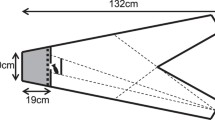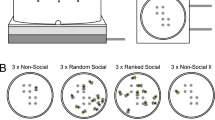Abstract
Group living is a common strategy among animals and has arisen independently in over 300 species of Lepidoptera. Yet, activity synchrony between individuals is necessary to derive the benefits that ensue from an aggregated lifestyle. Which individuals decide which activities to perform and when to perform them is, therefore, a fundamental question. In some species of social caterpillars and sawflies, the role of a potential behavioral polyethism between individuals has been suggested, whereby certain individuals are consistently more likely to initiate and lead a foraging event. However, in these cases, evidence in support of division of labor is lacking. This study was undertaken to determine if certain individuals of Malacosoma disstria are more likely to be consistent group leaders or if transient leaders could be predicted by the differences in energetic states between individuals. The results of this study indicate that unfed caterpillars initiate foraging bouts and are more likely to lead locomotion. There was no size or sex-based bias in those individuals that acted as temporary leaders. Consistent behavioral differences between individuals, if they exist, are therefore not necessary to explain task allocation and synchronization during foraging in this species.




Similar content being viewed by others
References
Addy ND (1969) Rearing the forest tent caterpillar on an artificial diet. J Econ Entomol 62:270–271
Barton Browne L (1993) Physiologically induced changes in resource-oriented behavior. Annu Rev Entomol 38:1–25
Beauchamp G (2000) Individual differences in activity and exploration influence leadership in pairs of foraging zebra finches. Behaviour 137:301–314
Bumann D, Krause J, Rubenstein DI (1997) Mortality risk of spatial positions in animal groups: the danger of being in the front. Behavior 134:1063–1076
Colasurdo N, Despland E (2005) Social cues and following behavior in the forest tent caterpillar. J Insect Behav 18:77–87
Conradt L, List C (2009) Group decisions in humans and animals: a survey. Philos Trans R Soc Lond B Biol Sci 364:719–742
Conradt L, Roper TJ (2005) Consensus decision making in animals. Trends Ecol Evol 20:449–456
Cornell JC, Stamp NE, Bowers MD (1988) Variation and developmental change in activity of gregarious caterpillars, Hemileuca lucina (Saturniidae). Psyche 95:45–58
Couzin ID, Krause J, Franks NR, Levin SA (2005) Effective leadership and decision-making in animal groups on the move. Nature 433:513–516
Despland E, Hamzeh S (2004) Ontogenetic changes in social behaviour in the forest tent caterpillar, Malacosoma disstria. Behav Ecol Sociobiol 56:177–184
Despland E, Le Huu A (2007) Pros and cons of group living in the forest tent caterpillar: separating the roles of silk and of grouping. Entomol Exp Appl 122:181–189
Despland E, Simpson SJ (2006) Resource distribution mediates synchronization of physiological rhythms in locust groups. Philos Trans R Soc Lond B Biol Sci 273:1517–1522
Dostalkova I, Spinka M (2007) Synchronization of behaviour in pairs: the role of communication and consequences in timing. Anim Behav 74:1735–1742
Dussutour A, Simpson SJ, Despland E, Colasurdo N (2007) When the group denies individual nutritional wisdom. Anim Behav 74:931–939
Dyer JRG, Johansson A, Helbing D, Couzin IA, Krause J (2009) Leadership, consensus decision making and collective behaviour in humans. Philos Trans R Soc Lond B Biol Sci 364:781–789
Edgerly JS, Fitzgerald TD (1982) An investigation of behavioral variability within colonies of eastern tent caterpillar Malacosoma americanum (Lepidoptera:Lasiocampidae). J Kans Entomol Soc 55:145–155
Fischhoff IR, Sundaresan S, Cordingley J, Larkin HM, Sellier MJ, Rubenstein D (2007) Social relationships and reproductive state influence leadership roles in movements of plains zebra, Equus burchellii. Anim Behav 73:825–831
Fitzgerald TD (1995) The tent caterpillars. Cornell University Press, Ithaca
Fitzgerald TD (2003) Role of trail pheromone in foraging and processionary behavior of pine processionary caterpillars Thaumetopoea pityocampa. J Chem Ecol 29:513–532
Fitzgerald TD, Costa JT (1986) Trail-based communication and foraging behavior of young colonies of forest tent caterpillars (Lepidoptera: Lasiocampidae). Ann Entomol Soc Am 79:999–1007
Fitzgerald TD, Costa JT (1999) Collective behavior in social caterpillars. In: Detrain C, Deneubourg JL, Pasteels JM (eds) Information processing in social insects. Birkhauser, Basel
Gautrais J, Michelena P, Sibbald A, Bon R, Deneubourg JL (2007) Allelomimetic synchronization in Merino sheep. Anim Behav 74:1443–1454
Greenblatt JA, Witter JA (1976) Behavioral studies on Malacosoma disstria (Lepidoptera:Lasiocampidae). Can Entomol 108:1225–1228
Grisdale D (1985) Malacosoma disstria. In: Singh P, Moore RF (eds) Handbook of insect rearing. Elsevier, Amsterdam, pp 369–379
Halloy J, Sempo G, Caprari G, Rivault C, Asadpour M, Tâche F, Saïd I, Durier V, Canonge S, Amé JM, Detrain C, Correll N, Martinoli A, Mondada F, Siegwart R, Deneubourg JL (2007) Social integration of robots into groups of cockroaches to control self-organized choices. Science 318:1155–1158
Harcourt JL, Ang TZ, Sweetman G, Johnstone RA, Manica A (2009) Social feedback and the ermergence of leaders and followers. Curr Biol 19:248–252
Holekamp KE, Boydston EE, Smale L (2000) Group travel in social carnivores. In: Boinski S, Garber PA (eds) On the move. University of Chicago Press, Chicago, pp 587–627
Huse G, Railsback S, Fernö A (2002) Modelling changes in migration pattern of herring: collective behaviour and numerical domination. J Fish Biol 60:571–582
King AJ, Cowlishaw G (2009) All together now: behavioural synchrony in baboons. Anim Behav 78:1381–1387
Krause J (1993) The relationship between foraging and shoal position in a mixed shoal of roach (Rutilus rutilus) and chub (Leuciscus cephalus): a field study. Oecologia 93:356–359
Krause J, Bumann D, Todt D (1992) Relationship between the position preference and nutritional state of individuals in schools of juvenile roach (Rutilus rutilus). Behav Ecol Sociobiol 30:177–180
Krause J, Reeves P, Hoare D (1998) Positioning behaviour in roach shoals: the role of body length and nutritional state. Behaviour 135:1031–1039
Laux W (1962) Individuelle unterschiede in verhalten und leistung des ringelspinners, Malacosoma neustria (L.). Z Angew Zool 49:465–524
Leblond C, Reebs SG (2006) Individual leadership and boldness in shoals of golden shiners (Notemigonus crysoleucas). Behaviour 143:1263–1280
Long DB (1955) Observations on subsocial behaviour in two species of lepidopterous larvae, Pieris brassicae L. and Plusia gamma L. Trans R Entomol Soc Lond 106:421–437
McClure M, Despland E (2010) Collective foraging patterns of field colonies of Malacosoma disstria caterpillars. Can Entomol 142:1–8
Nemiroff L, Despland E (2007) Consistent individual differences in the foraging behaviour of forest tent caterpillars (Malacosoma disstria). Can J Zool 85:1117–1124
Peters MI, Despland E (2006) Plasticity in forest tent caterpillar self-organized collective foraging. Ethology 112:521–528
Petit O, Bon R (2010) Decision-making processes: the case of collective movements. Behav Processes 84:635–647
Ramseyer A, Thierry B, Boissy A, Dumont B (2009) Decision-making processes in group departures of cattle. Ethology 115:948–957
Rands SA, Cowlishaw G, Pettifor RA, Rowcliffe JM, Johnstone RA (2003) Spontaneous emergence of leaders and followers in foraging pairs. Nature 423:432–434
Reebs SG (2001) Influence of body size on leadership in shoals of golden shiners, Notemigonus crysoleucas. Behaviour 138:797–809
Ruf C (2002) Social life-styles in caterpilars: behavioral mechanisms and ecological consequences. Dissertation, Universität Bayreuth
Sokal RR, Rohlf FJ (1981) Biometry: the principles and practices of statistics in biological research, 2nd edn. W.H Freeman and Company, New York
Stewart KJ, Harcourt AH (1994) Gorillas’ vocalizations during rest periods: signals of impending departure? Behaviour 130:1–2
Sumpter DJT, Pratt SC (2009) Quorum responses and consensus decision making. Philos Trans R Soc Lond B Biol Sci 364:743–753
Underwood DLA, Shapiro AM (1999) Evidence for division of labor in the social caterpillar Eucheira socialis (Lepidoptera: Pieridae). Behav Ecol Sociobiol 46:228–236
Weinstein P, Maelzer DA (1997) Leadership behaviour in sawfly larvae Perga dorsalis (Hymenoptera: Pergidae). Oikos 79:450–455
Wellington WG (1957) Individual differences as a factor in population dynamics: the development of a problem. Can J Zool 35:293–323
Werner EE, Anholt BR (1993) Ecological consequences of the tradeoff between growth and mortality rates mediated by foraging activity. Am Nat 142:242–272
Acknowledgments
Thanks go to Dr. Barry Cooke for providing the egg masses and to Stéphane Daigle of Centre d’Étude de la Forêt (CEF) for assistance with the statistical analysis. Financial support was provided by the Canadian Natural Sciences and Engineering Research Council as a Discovery Grant to E.D., and by le Fonds Québecois de la Recherche sur la Nature et les Technologies as a Graduate Student Research Award to M.M. The experiments comply with the current laws of the country in which they were performed.
Conflict of interest
The authors declare that they have no conflict of interest.
Author information
Authors and Affiliations
Corresponding author
Additional information
Communicated by J. Krause
Rights and permissions
About this article
Cite this article
McClure, M., Ralph, M. & Despland, E. Group leadership depends on energetic state in a nomadic collective foraging caterpillar. Behav Ecol Sociobiol 65, 1573–1579 (2011). https://doi.org/10.1007/s00265-011-1167-5
Received:
Revised:
Accepted:
Published:
Issue Date:
DOI: https://doi.org/10.1007/s00265-011-1167-5




